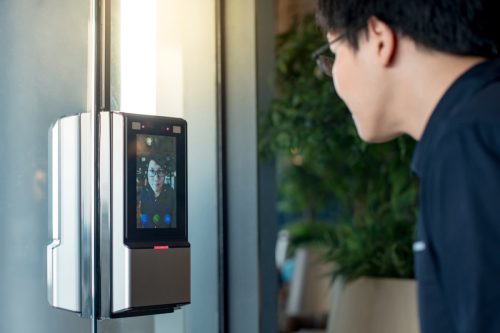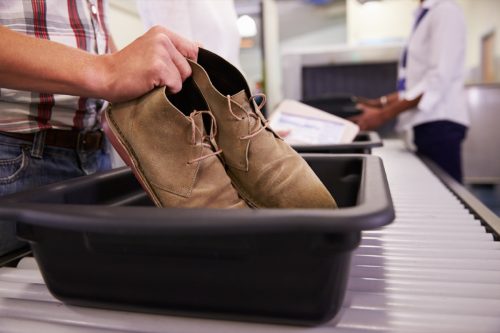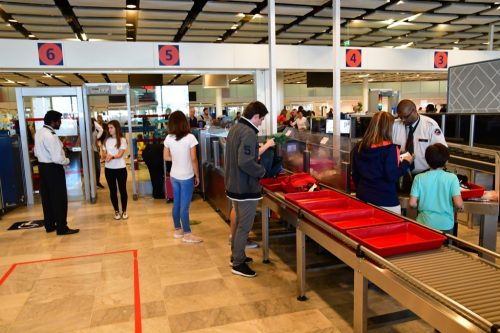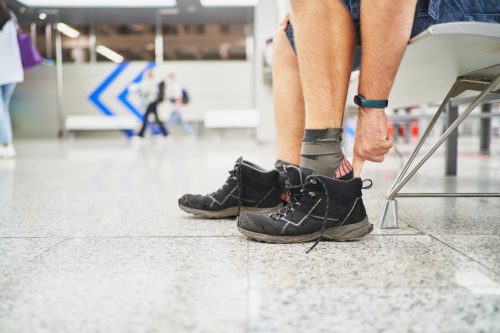TSA Is Under Fire for Safety Risks in Airport Security Lines

Airport security is one of those rare experiences that all travelers can agree on—namely that it’s one of the most stressful aspects of flying. At the same time, airport security is widely considered to be a necessity that’s designed to keep travelers safe. But now, the Transportation Security Administration (TSA) is under fire for safety risks that could put passengers in danger, according to a new lawsuit. Read on to find out why TSA is being sued.
READ THIS NEXT: TSA Is Making Another Major Change to Airport Security.
TSA often faces criticism for its policies.

Ask anyone how they feel about airport security, and you’re likely to get an earful. It seems like everyone has an opinion about TSA—namely, what they could be doing better.
Last week, TSA faced backlash for its introduction of facial recognition technology at U.S. airports. According to a press release, the second generation of Credential Authentication Technology (CAT) machines for identification have been rolled out, dubbed CAT-2. The agency states that new machines provide an extra layer of security by taking a photo of passengers when they reach the checkpoint, then comparing and matching the photos to an “identification credential.”
But according to The Washington Post, another TSA trial using this tech is “more invasive,” in that you don’t even need to present an ID. In this case, your real-time photo is taken and compared against photos in an existing government database—typically passport photos. The process has experts concerned about how it will affect certain travelers, as research suggests that the tech is not as accurate for people of color. Additionally, there are worries about the use of people’s biometric data, despite TSA saying that photos are never saved and participation isn’t required.
While the protection of your data is vital, there are some more immediate concerns for travelers across the county. Recently, a woman was injured at a California airport, prompting a larger conversation—and a lawsuit—about safety risks at TSA security checkpoints.
A woman was seriously injured making her way through the TSA line.

On Nov. 28, Luann Rein of San Diego filed a lawsuit against the U.S. government and the San Diego County Regional Airport Authority, stating that she suffered a traumatic brain injury while making her way through a security checkpoint, ABC-affiliate KGTV reported.
Rein, who was 68 at the time of the incident, put her cane on the conveyer belt to be screened and walked through the X-ray body scanner. The machine went off, the lawsuit says, per KGTV, and she was then instructed by TSA agents to take off her shoes and go through again.
“Plaintiff looked for a place where she could take off her shoes,” the lawsuit states. “However, there was no chair to sit in for this purpose.” As a result, Rein placed her left hand on a temporary stanchion (the vertical bar used to keep the line sectioned off and organized) and her right hand on her husband, Don Rein, who was removing her shoes for her, video surveillance shows. But as her husband was taking off her second shoe, the stanchion began to wobble and caused Rein to lose her balance.
“The momentum of the sudden weight shift due to the movement of the unstable stanchion, combined with her attempt to keep herself from falling, caused Plaintiff to spin around as she lost her balance, fell, and hit the back of her head hard on the terrazzo floor, causing her to lose consciousness,” the lawsuit reads, according to KGTV.
RELATED: For more up-to-date information, sign up for our daily newsletter.
The issue could have been avoided, the lawsuit states.

In addition to the traumatic brain injury, Rein also had a concussion and back pain, among other injuries, her husband told KGTV. “I didn’t know how bad it was, but kind of when you see blood from the back of the head you know something serious happened,” he said.
The lawsuit alleges that there were no signs warning people going through security that the stanchions were unstable or unsafe to lean on. “You expect that certainly steps will be taken so that you won’t have a risk of injury,” Lincoln Horton, Rein’s attorney, told KGTV.
The lawsuit is requesting compensation on the basis of negligence and premise liability as “defendants’ employees created a dangerous condition in the security lane where Plaintiff attempted to go through by failing to have a chair for Plaintiff to sit in while she complied with Defendants’ employees’ order to remove her shoes.”
Rein’s lawyer says TSA should be held accountable.

After getting through the security checkpoint, you expect to see benches or chairs for people to put their shoes back on after taking them off during screening. However, it’s much less common to see chairs or benches situated ahead of the checkpoint or near the screening equipment itself. According to Horton, the agency should be held accountable for failing to provide seating at one stage but not the other.
“It doesn’t make any sense to me at all that they have chairs beyond the security line but not before the security line,” Horton told KGTV. “If a governmental agency is going to tell you to take off your shoes, they need to provide a chair for you to make sure you can do so safely and that didn’t happen in this case.”
Both the San Diego County Regional Airport Authority and TSA told Best Life that they do n0t comment on pending litigation.